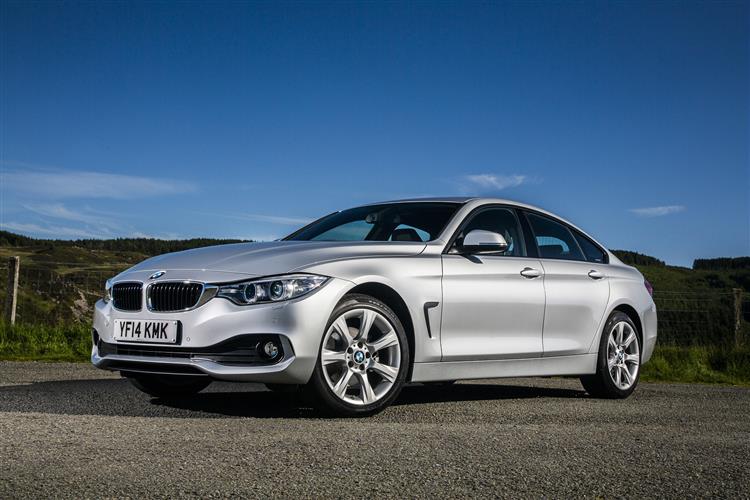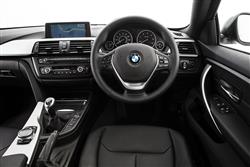How will you view?
This is a sample, showing 30 seconds of each section.
GRANDER DESIGN (some text hidden) SECTIONED_new_bmw4seriesgrancoupe_2014
By Jonathan Crouch
Introductionword count: 83
The first generation 'F36'-series version of BMW's 4 Series Gran Coupe, sold between 2014 and 2020, offers a flexibly stylish choice in the mid-sized executive segment. For once, two rear doors don't compromise the visual appeal of a model of this kind, nor does their extra weight dilute the handling purity. Of course, there are more practical choices in this segment from this era - and certainly cheaper ones. After trying this BMW though, you might not be quite so attracted to them.
Modelsword count: 42
5dr executive hatch (Petrol - 2.0 184hp [420i] & 252hp [430i], 6 cylinder 326hp [440i], 6 cylinder 431hp [M4] / Diesel - 2.0 190hp [420d], 3.0 6 cylinder 258hp [430d] or 313hp [435d] - trim levels SE, Sport, Luxury & M Sport)
Historyword count: 531
Our business carparks are full of cars owned by people who'd really rather be driving something else. In many cases, they'll have something practical with five doors - when what they'd really like is a smart sports coupe. Any brand with a product able to offer the best of both will have a successful sales proposition on its hands - the kind of thing in fact boasted by this model - the first generation version of BMW's 4 Series Gran Coupe, originally launched in 2014. You might already be familiar with the kind of car this is - a coupe that also offers a set of conventional rear doors, while managing to stay relatively stylish and individual. As long ago as 2008, Volkswagen arguably pioneered this idea in the mid-sized class with their Passat CC, building on a concept Mercedes had already introduced in the larger executive segment back in 2005 with their CLS-Class. Of course, it didn't take long for other brands to notice and follow suit. Of these, Audi were the cleverest, deciding that if you wanted to create a practical car that looked and drove like a coupe, the best thing to start with was a coupe - something like their A5. Re-working that car into a sensible five-door hatch that was still rather smart can't have been easy, but the A5 Sportback model they introduced in 2010 as a result of that thinking rewarded them by selling in such prodigious numbers that rivals BMW had to respond. Mind you, it took Munich until the middle of 2014 to properly do so and bring us this 4 Series Gran Coupe. They'd wanted to wait until the launch of their 4 Series model line in 2013 before doing an extended coupe version, but in the interim, the brand took the opportunity to test the concept with their larger 6 Series Gran Coupe, a variant that quickly accounted for over 60% of all 6 Series model sales. Important then, for them to have a smaller 4 Series-based version, even though BMW dealers in this period could already offer two smart five-door models to customers shopping in the compact executive market segment - namely the 3 Series Touring estate and the 3 Series Gran Turismo five-door hatch. Commentators like us wondered whether there was really room in the company's range for another similarly-sized, similarly-priced five-door design sharing most of the same mechanicals and all of the same engines as these two existing models. The Bavarians though, were determined to find out. They pointed out that a car bearing the 4 Series badge could be a slightly more focused thing than one from the 3 Series range. And that, free from the over-riding shackles of practicality that had toslightly compromise the style of 3 Series Touring or Gran Turismo models, this 4 Series Gran Coupe could be a much more stylish thing - and so at last properly challenge that Audi A5 Sportback model whose success it clearly wanted to emulate. The car was lightly facelifted and updated with various new petrol engines and suspension changes in 2017. And in that form, it sold until mid-2021, when a second generation design arrived.
What You Getword count: 515
If we accept that one of the primary purchasing priorities for potential buyers of this car is going to be the way it looks, then BMW seems very well set here. This 4 Series Gran Coupe appears at first glance to be larger than the two-door 4 Series Coupe model it's based upon - indeed, you would have thought that a Gran Coupe would have to be to accommodate its two extra rear doors and larger boot. Apparently not. As it turns out, the extra versatility comes solely through changes to the shape of the roof - it's 112mm longer and sits 12mm higher. Otherwise, all of the other basic dimensions of this car - body length, width, wheelbase and so on - replicate not only the ordinary MK1 4 Series Coupe but also the 3 Series saloon it was originally derived from. Certainly the long bonnet, the short overhangs and the set-back passenger compartment are very familiar. After admiring the outside, particularly eye-catching if you've paid the extra for M Sport trim, you might be expecting more from the interior than BMW actually delivered. Yes, the way the look of the cabin flows right around the inside of the doors and into the rear seating area is a neat distinguishing touch but otherwise, you could be in pretty much any of the Munich maker's 3 or 4 Series models. That means a set of virtually faultless ergonomics but also cabin that can feel a little dull and plain unless you get a car whose cabin was lifted by the original owner with some of the more colourful trim treatments. The driving position's lower-set than it would be in the kind of more ordinary 3 Series model that shares most of its engineering with this car. And you get a leather-wrapped sports steering wheel that feels great to hold. The level of infotainment on offer was upgraded with the facelifted version of this model introduced in 2017, though still not to the point where the high-mounted centre-dash screen could be touch-sensitive. Standard models come with a 6.5-inch monitor, but most original owners upgraded to the larger 8.8-inch display that's standard with the more capable 'BMW Professional' media package. And in the rear? Well the process of getting in through the lovely frameless doors is a little inhibited by the wheel arches - you have to climb in and then fall back onto the cushion. Once you're in place on the back seat, that stretched, heightened roofline delivers head and legroom that are both remarkably good for a car still professing to be a 'coupe' - though if you're expecting to carry five people and use all three rear belts provided, you might need a bit of a reality check. BMW describes this car as a '4+1' seater, which means that it's been designed for four but has a centre rear bench that can be used for a child or, in emergency, by an adult. The luggage bay, though shallow and accessible only over quite a high loading lip, is decently sized, with 480-litres on offer.
To see the full road test text contact us on 0330 0020 227
Pictures (high res disabled)

.jpg)
|
.jpg)
|
.jpg)
| |||
.jpg)
|
.jpg)
|
.jpg)
| |||
.jpg)
|
.jpg)
|
.jpg)
| |||

|
Scoring (subset of scores)
Category: Coupes
| Performance | |
| Handling | |
| Comfort | |
| Space | |
| Styling, Build, Value, Equipment, Depreciation, Handling, Insurance and Total scores are available with our full data feed. | |



